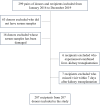Assessing donor kidney function: the role of CIRBP in predicting delayed graft function post-transplant
- PMID: 39896811
- PMCID: PMC11782215
- DOI: 10.3389/fimmu.2024.1518279
Assessing donor kidney function: the role of CIRBP in predicting delayed graft function post-transplant
Abstract
Introduction: Delayed graft function (DGF) shortens the survival time of transplanted kidneys and increases the risk of rejection. Current methods are inadequate in predicting DGF. More precise tools are required to assess kidney suitability for transplantation. Cold-inducible RNA-binding protein (CIRBP) expression has been linked to acute kidney injury, suggesting its potential as a new biomarker for transplanted kidney function.
Methods: We included deceased donors and recipients who had undergone successful kidney transplantation between 2016 and 2019. Recipients and their paired donors are assigned to either the DGF or immediate graft function (IGF) group, based on the recipient's recovery of graft renal function. Donor plasma CIRBP levels were measured using an enzyme-linked immunosorbent assay kit to assess their relationships with DGF.
Results: Donor plasma CIRBP concentrations in the DGF group were approximately twice as high as those in the IGF group (6.82 vs. 3.44; P<0.001). DGF occurred in all cases where CIRBP concentrations exceeded 7.92 ng/mL. Furthermore, univariate and multivariate analyses (odds ratio [OR]=1.660; P<0.001) confirmed that donor plasma CIRBP level was an independent risk factor for DGF. Additionally, higher CIRBP levels were associated with increased plasma creatinine at 6 months (R²=0.08; P<0.001), and survival analysis showed shorter kidney survival in recipients with DGF (P=0.002).
Conclusions: This study demonstrated that donor plasma CIRBP levels can effectively predict the occurrence of DGF. CIRBP is a potential novel biomarker for evaluating transplanted kidney function.
Clinical trial registration: https://clinicaltrials.gov, identifier NCT06641622.
Keywords: acute kidney injury; cold-inducible RNA binding protein; delayed graft function; graft survival; kidney transplantation.
Copyright © 2025 Leng, Ma, Tang, Jiang, Han and Huang.
Conflict of interest statement
The authors declare that the research was conducted in the absence of any commercial or financial relationships that could be construed as a potential conflict of interest.
Figures





Similar articles
-
Pre-transplant HLA Antibodies and Delayed Graft Function in the Current Era of Kidney Transplantation.Front Immunol. 2020 Aug 26;11:1886. doi: 10.3389/fimmu.2020.01886. eCollection 2020. Front Immunol. 2020. PMID: 32983110 Free PMC article.
-
Deceased donor neutrophil gelatinase-associated lipocalin and delayed graft function after kidney transplantation: a prospective study.Crit Care. 2011;15(3):R121. doi: 10.1186/cc10220. Epub 2011 May 5. Crit Care. 2011. PMID: 21545740 Free PMC article.
-
Preoperative donor urinary UDP-Glc as an independent risk factor for delayed graft function.Front Immunol. 2025 Mar 17;16:1545280. doi: 10.3389/fimmu.2025.1545280. eCollection 2025. Front Immunol. 2025. PMID: 40165952 Free PMC article.
-
Machine perfusion preservation versus static cold storage for deceased donor kidney transplantation.Cochrane Database Syst Rev. 2019 Mar 15;3(3):CD011671. doi: 10.1002/14651858.CD011671.pub2. Cochrane Database Syst Rev. 2019. Update in: Cochrane Database Syst Rev. 2024 Jul 9;7:CD011671. doi: 10.1002/14651858.CD011671.pub3. PMID: 30875082 Free PMC article. Updated.
-
In kidney recipients from the same deceased donor, discordance in delayed graft function is associated with the worst outcomes.Clin Transplant. 2022 Sep;36(9):e14779. doi: 10.1111/ctr.14779. Epub 2022 Jul 27. Clin Transplant. 2022. PMID: 35848635 Review.
Cited by
-
Opportunities and challenges with the implementation of normothermic machine perfusion in kidney transplantation.Nat Commun. 2025 Jul 25;16(1):6883. doi: 10.1038/s41467-025-60410-3. Nat Commun. 2025. PMID: 40715058 Free PMC article. Review.
References
Publication types
MeSH terms
Substances
Associated data
LinkOut - more resources
Full Text Sources
Medical

